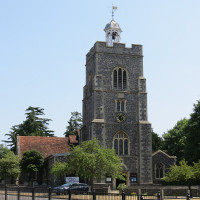 St John the Baptist, Hillingdon, London.
St John the Baptist, Hillingdon, London.
 St John the Baptist, Hillingdon, London.
St John the Baptist, Hillingdon, London.
St John the Baptist Church in Hillingdon contains a rich crop of monuments: two major ones from the 17th and 18th Centuries, and about 30 tablets from the 1600s through to the 20th Century, with particular strengths in the earlier period. The church stands a little outside from the town centre of Uxbridge, on the Hillingdon Road – Hillingdon Tube Station is no nearer than the Uxbridge one – but is easily walkable from either.
The body of the church itself is of the 14th Century, with some bits from the 13th Century and the square tower dating from 1629. It had a major restoration in the 1840s – the longer nave and chapels, and the chancel were added at this time, though the chancel arch is the very earliest part of the church: it retains a corbel with carvings of little beasts and a head. One of the two symmetrical aisles has several small carved half-figures as corbels supporting the beams of the roof – odd little things, cramped and medieval.
Now to the monuments. First the two grand ones:
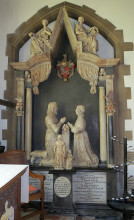
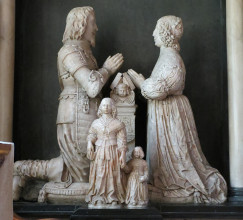
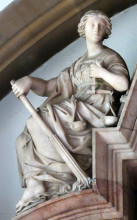
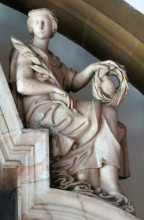 Edward Carr Monument, and allegorical figures.
Edward Carr Monument, and allegorical figures.
Sir Edward Carr, d.1636/7, put up by his wife Dame Jane, daughter of Sir Edward Onslow of Knowle. A grand monument of the kneelers type (see this page), but of a size and quality far above the norm. The freestanding white marble figures kneel on cushions, facing each other across the normal little prayer desk. He wears armour above baggy trousers and tall, crinkly boots; she a fine skirt and top with puffed arms, and a cap above her ringletted hair. In front and facing forwards, two daughters, of much smaller size, the elder as a miniature young woman, the younger clearly a small child, both standing and holding hands. The group rests on a chest tomb, and a free standing pillar rises on each side, then a square pilaster, with in front of it a shorter pillar bearing the beast from the relative crests of the two families – a white hart for Sir Edward, an eagle for Dame Jane. Above, a canopy with tall pointed centre, leaving space for a large shield of arms (his). Knotted curtains are drawn up on each side, and on top, on either side of the central peak in the spandrel positions, sit relatively large allegorical girls. Justice is on the left as we look at the monument, holding her scales in one hand, the other snuffing out a long torch, indicating the extinction of the male line, though the two daughters included in the monument survived him [for those anxious as to the continuation of the family, it will be reassuring to know that his elder daughter, Philadelphia, married a baronet and had 9 children, some of whom kept a connection with Hillingdon]. On the other side, the figure holds a Victory wreath with a dove sitting inside, rather touchingly (it may represent the soul, thus 'victory over death'), and in her other hand, a leafy branch. Both figures are of course classical, wearing long drapes leaving arms and feet bare. (If you like allegorical figure sculpture, there are many on this site, linked on this page.) The whole ensemble combines a variety of white, black and coloured marbles and alabaster, and has a variety of additional minor carving and winged cherubic heads to give an overall sense of richness and opulence. One of the inscriptions on the base notes the repair of the monument in 1775, by the Rt Hon George Onslow.
Monument to Lord Henry Paget, Earl of Uxbridge.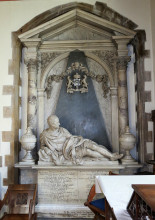
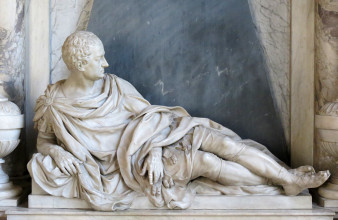
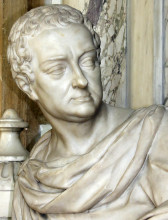
Lord Henry Paget, Earl of Uxbridge, Baron Pagett of Beaudesert, and Baron of Burton in the County of Stafford, d.1743. The inscription to this noble monument notes his two wives, the second of whom, Elisabeth, daughter of Sir Walter Bagott, died in 1749 and is commemorated with an additional small inscription. A full length white marble effigy of Lord Paget has him reclining Roman fashion on one arm, legs crossed, draped likewise in Roman attire and wearing open sandals, and with tightly curled hair increasing the impression that here is a modern-day Caesar. He reclines upon a chest tomb, with large pots to either side, and in front of a portico. This has detached Composite pillars, with plainer pilasters behind, supporting a pediment with under it an arch, so that there are two spandrels, with decorative carving (lots of examples of spandrel decorations are noted on this page). Behind the figure, a tall black obelisk rises to cover the centre of the arch, bearing the coat of arms, and with an ornate garland of flowers above it. The figure was at one time attributed to Peter Scheemakers, presumably on stylistic grounds – while he certainly made figures in some degree similar to this one, I am not familiar enough with his work to offer a view.
Next to note is a series of 18th Century wall monuments to the connected Newdegate Family and Nicoll Family:
There are three of these:
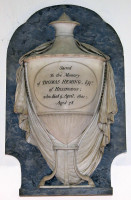 Thomas Heming of Hillingdon, d.1801.
Thomas Heming of Hillingdon, d.1801.
And the rest of the monuments, in date order, with some of particular interest:
Local stonemasons' work: Tomlinson of Uxbridge, and E. Burgiss of Uxbridge.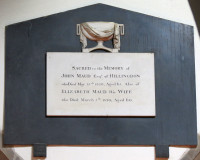
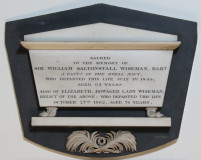
A large stone slab bears the brasses of Drew Saunders, d.1579, consisting of separate insets of the inscription, husband and wife figures, smaller figures of son and daughter, behind the father and mother respectively in the usual fashion, with everyone praying, and above the figures, a diamond shape bearing a sigil which would appear to be Saunders’ mark, incorporating a D and an S. There is an indent where an upside down shield would once have been, between the figures. The delineation of the figures shows them standing, heavily draped enough so that there is little sense of the lines of the figure underneath, posed gazing somewhat inwards to face almost towards each other, and thus their praying hands are shown in three-quarters view. As a merchant, Saunders wears robes rather than armour, and we can see he is wearing ruffed sleeve cuffs and richly padded shoulders, suggesting wealth. He has a short beard and shoulder length hair. His wife has a long robe covering the feet, sleeves flared at the top, tight-fitting lower down, with ruffs again, and a big ruff at the neck, and wears a bonnet or hood so that her face is framed. Her face, which on an effigy of a little later would generally be rather old and unflattering, is here youthful, with a nice rendering of lips and chin and cheek. There is something of a presence in these figures, a feel that we are really gazing on two individuals as they looked nearly 450 years ago.
Separate stone panels bear small, fragmentary brasses, including shields, and more interestingly, a group of six standing boys, who would be the sons ranged behind or beneath some central figure, now lost, and a separate group, of three girls, which would similarly have been placed behind or under the mother, and two of which would seem to have died before their parents. Another panel shows the caped body and hands from another brass, which would have been either a male clerical figure or, less likely, a cloaked woman.
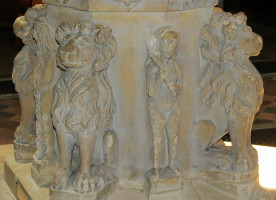
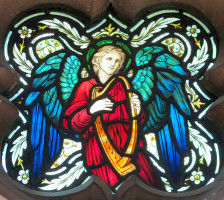 Carving on base of font, and Arts and Crafts stained glass.
Carving on base of font, and Arts and Crafts stained glass.
We may note the pulpit, alabaster highly carved with leafy borders, and little Gothic recesses all the way round bearing figures of saints. Rather late 19th Century, I would think. The font is interesting: a great circular bowl, with an octagonal surround, with alternate panels of angels and birds or winged beasts. More angels under the curve of the bowl. Below, on the base, a naked figure in the centre of each of the four sides, and a seated lion at each corner with curly locks to the mane. The figures are medieval in style, with large heads and lively carving, and the lions are also early in look. Whatever the original date, I would guess the upper part had a good makeover in the later 19th Century, and the lower part with figures and beasts was just tidied up a little.
Finally, the stained glass. There is not so much of it, but we must mention firstly a rather fine Virgin and Child, with particularly good face and hands of the Virgin, and little panels of what we must presume is William Morris glass with Angel-musicians, very much in the style of Burne-Jones, but the faces a little hard-edged for his hand. Alfred Parsons perhaps, but I really have no idea. An asset, regardless.
Outside, in the compact graveyard, overgrown with ivy and very atmospheric, is the much remarked on tomb of John Rich, d.1761, patentee of Covent Garden and inventor of the English Harlequin. His tomb is rather an ornate thing, consisting of a great stone casket, slanting outwards at the sides, with a heavy lid carved with a cartouche bearing arms, crossed branches and scrolling at the corners, converging to a square, flat top which may once have borne an urn. The upper lip of the casket is carved with a leaf and flower pattern, and the ivy-covered base has further minor decorative carving, all appropriately scaled for the size of monument, and is supported on four heavy scrolled feet. Panels on the side record a brief eulogy to Rich, and other members of the family, including his second wife Amy, his daughters and their husbands.
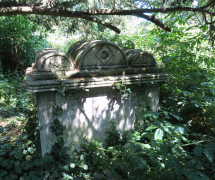 One of several chest tombs in the evocative churchyard.
One of several chest tombs in the evocative churchyard.
There is a good collection of other chest tombs, none so ornate as that of John Rich, ivy clad and evocative, from the 18th and early 19th Centuries. Among the headstones, there are several with a carved skull and crossbones at the top, from the early 18th Century, and others with a sunburst design, as well as other minor decorative carving.
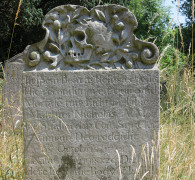 18th Century headstone with carved skull and crossbones.
18th Century headstone with carved skull and crossbones.
With many thanks to the Church authorities for permission to show pictures of the monuments inside; their website is http://www.stjohnshillingdon.org.uk/resources/churchhistory.
Ruislip Church, also in Hillingdon // West Drayton Church, Hillingdon // Hayes Church // Uxbridge Church // Greenford Church // Denham Church, near Uxbridge // Sculpture on the Uxbridge Line
Burgiss of Uxbridge, stonemasons // Monuments in some London Churches // Churches in the City of London // Introduction to church monuments
Angel statues // Cherub sculpture
Visits to this page from 13 Mar 2014: 17,752